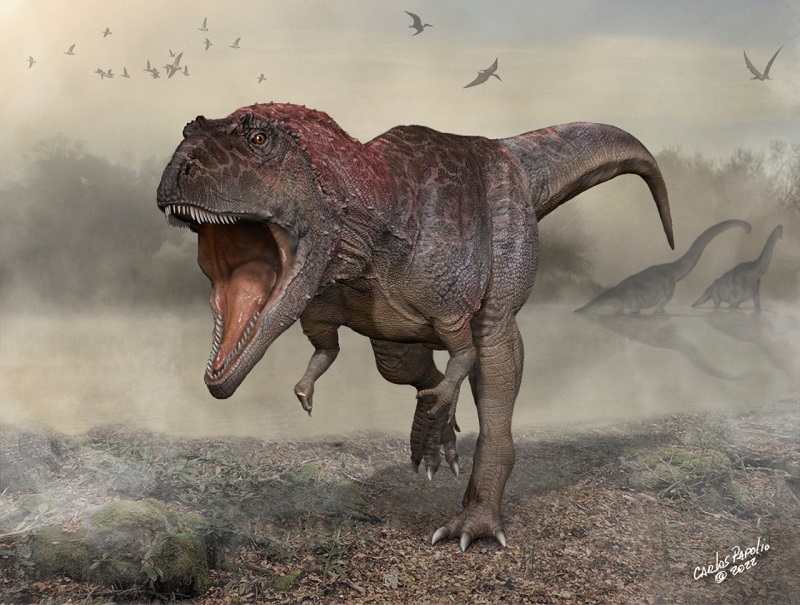
A reconstruction of the skull of Cretaceous Period meat-eating dinosaur Meraxes gigas, whose fossils, including a nearly complete skull, were unearthed in Argentina’s northern Patagonia region, seen in an undated photo.
20:15 JST, July 27, 2022
Fossils found in Argentina of a ferocious dinosaur with a huge head covered in bumps and crests reminiscent of a gargoyle are providing insight into the evolution of some of Earth’s biggest predatory dinosaurs including a curious trend toward puny arms.
Scientists said on July 7 they discovered in northern Patagonia extensive skeletal remains of a previously unknown species called Meraxes gigas, including one of the most complete skulls of a large meat-eating dinosaur ever unearthed. Meraxes, which lived about 90 million years ago during the Cretaceous Period, was roughly 11 meters to 12 meters long and weighed about 4 tons.
All meat-eating dinosaurs belonged to a bipedal assemblage called theropods. Meraxes was a member of a theropod lineage called carcharodontosaurs — the so-called shark-toothed dinosaurs — that included the even-larger Giganotosaurus, also from Patagonia, and Carcharodontosaurus, from Africa.
The Meraxes skull measured more than 127 centimeters long, according to paleontologist Juan Ignacio Canale of the Argentine research agency CONICET at the Ernesto Bachmann Paleontological Museum, lead author of the study published in the journal Current Biology.
“Many of the bones of the face and skull roof were covered with bumps, ridges and furrows, giving it a gnarly appearance like a medieval gargoyle,” said University of Minnesota paleontologist and study coauthor Pete Makovicky.
Meraxes, named after a dragon from the “Song of Ice and Fire” fiction series that inspired the TV show “Game of Thrones,” possessed strong jaws studded with 15-centimeter serrated teeth and the largest foot claws of any of the big theropods.
“A terrifying sight,” said paleontologist and study coauthor Sebastian Apesteguia of CONICET and the Felix de Azara Foundation.
Despite its big body size, its arms were just over 60 centimeters long — “absurdly short,” Makovicky said.
Two other Cretaceous theropod lineages — tyrannosaurs, which included North America’s T. rex, and abelisaurs, which included South America’s Carnotaurus — also evolved stubby arms.
Due to the incompleteness of the remains of other large carcharodontosaurs, Meraxes offered the first evidence of forelimb reduction in this group. Abelisaurs had hands with four fingers, while carcharodontosaurs reduced that to three and tyrannosaurs to two.

An artist’s reconstruction of Meraxes gigas
Scientists have wondered why three of the most important theropod groups independently evolved short arms of little use in predation. All three exhibited a trend toward increased head size and decreased forelimb size, suggesting a heavy reliance on the skull for taking down prey, the researchers said.
While diminutive in size, the Meraxes arms were stout and muscular.
“Despite their powerful appearance, it’s hard to imagine they were used much as they barely extend beyond the body and could not have reached the huge mouth,” Makovicky said.
“I’m inclined to think that they were used in other kinds of activities, like holding the female during mating or help in raising the body from a prone position,” Canale added.
Some other lineages of large theropods did not join the trend. Immense Spinosaurus, with an elongated skull well adapted for hunting aquatic prey, had intermediate-length arms. Strange Therizinosaurus and Deinocheirus, whose diets differed from other theropods, boasted relatively long arms with huge claws.
Carcharodontosaurs reached their peak diversity around 90 million years ago, then disappeared suddenly.
Meraxes is not the largest of this lineage but its remains are the most complete of the largest carcharodontosaurs, with nearly the entirety of the skull, hips and limbs — filling in some gaps in the understanding of this group.
For instance, based on the dimensions of the Meraxes skull, the researchers recalculated the skull length of Giganotosaurus at a whopping 168 centimeters. Giganotosaurus, the largest of this lineage, was slightly longer but not as heavily built as Tyrannosaurus rex, which lived tens of millions of years later.
Dinosaurs in this lineage, Apesteguia said, “are mysterious beasts to us.”
"Science & Nature" POPULAR ARTICLE
-

Mass Oyster Die-Offs Confirmed in Japan’s Seto Inland Sea; High Water Temperature Cited as Primary Cause
-

Genome Study Reveals Milestone in History of Cat Domestication
-

Big Leap in Quest to Get to Bottom of Climate Ice Mystery
-

Security Camera Footage Vulnerable to Outside Access; Investigation Finds 3,000 Pieces Exposed Online
-

Paws on Parade: Nairobi’s Dogs Dazzle at ‘Pawchella’
JN ACCESS RANKING
-

Keidanren Chairman Yoshinobu Tsutsui Visits Kashiwazaki-Kariwa Nuclear Power Plant; Inspects New Emergency Safety System
-

Imports of Rare Earths from China Facing Delays, May Be Caused by Deterioration of Japan-China Relations
-

University of Tokyo Professor Discusses Japanese Economic Security in Interview Ahead of Forum
-

Japan Pulls out of Vietnam Nuclear Project, Complicating Hanoi’s Power Plans
-

Govt Aims to Expand NISA Program Lineup, Abolish Age Restriction























